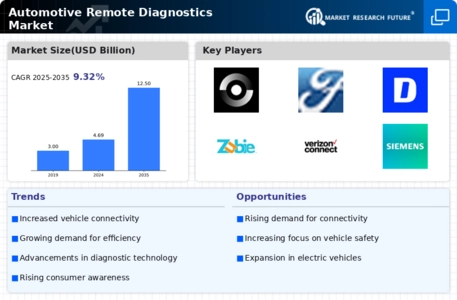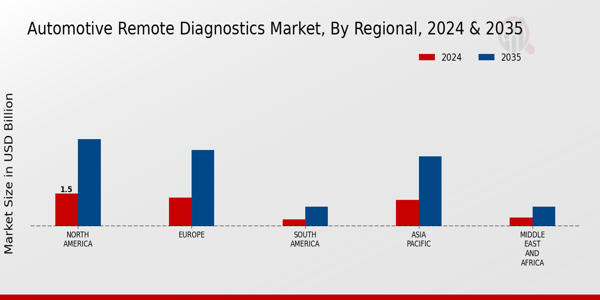Market Growth Projections
Increased Focus on Cost Efficiency
The increased focus on cost efficiency among automotive manufacturers is a significant driver of the Global Automotive Remote Diagnostics Market Industry. By implementing remote diagnostics, companies can reduce operational costs associated with traditional diagnostic methods, such as manual inspections and in-person service visits. Remote diagnostics facilitate quicker problem identification and resolution, leading to reduced vehicle downtime and enhanced service efficiency. This cost-saving potential is particularly appealing in a competitive market, where margins are often tight. As manufacturers seek to optimize their operations and improve profitability, the adoption of remote diagnostic solutions is likely to gain momentum, further fueling market growth.
Advancements in Diagnostic Technologies
Advancements in diagnostic technologies are a crucial factor propelling the Global Automotive Remote Diagnostics Market Industry. Innovations such as artificial intelligence and machine learning are enabling more accurate and efficient diagnostics, allowing for predictive maintenance and reducing downtime. These technologies facilitate real-time data analysis, which is essential for identifying potential issues before they escalate. The integration of advanced diagnostic tools not only enhances vehicle performance but also improves customer trust and loyalty. As the industry evolves, the adoption of these technologies is likely to accelerate, contributing to a compound annual growth rate of 9.32% from 2025 to 2035, underscoring the transformative impact of technological advancements.
Growing Demand for Vehicle Connectivity
The increasing demand for vehicle connectivity is a primary driver of the Global Automotive Remote Diagnostics Market Industry. As consumers seek enhanced features such as real-time monitoring and remote access to vehicle data, manufacturers are compelled to integrate advanced diagnostic systems. This trend is evidenced by the projected market value of 4.69 USD Billion in 2024, reflecting a significant shift towards connected vehicle technologies. The integration of IoT and telematics systems facilitates seamless communication between vehicles and service providers, thereby enhancing customer satisfaction and operational efficiency. This growing connectivity is likely to propel the market further as more consumers embrace smart vehicle solutions.
Regulatory Compliance and Safety Standards
Regulatory compliance and safety standards are increasingly influencing the Global Automotive Remote Diagnostics Market Industry. Governments worldwide are implementing stringent regulations to ensure vehicle safety and emissions control. For instance, the European Union has mandated the use of onboard diagnostics systems in vehicles, which necessitates the adoption of remote diagnostic tools. This regulatory landscape not only drives the demand for advanced diagnostic solutions but also encourages manufacturers to innovate and enhance their offerings. As a result, the market is expected to expand significantly, with a projected value of 12.5 USD Billion by 2035, indicating the critical role of compliance in shaping industry dynamics.
Rising Consumer Awareness and Expectations
Rising consumer awareness and expectations regarding vehicle performance and maintenance are driving the Global Automotive Remote Diagnostics Market Industry. As consumers become more informed about the benefits of remote diagnostics, they increasingly demand transparency and proactive maintenance solutions from manufacturers. This shift in consumer behavior is prompting automotive companies to invest in remote diagnostic capabilities to meet these expectations. Enhanced customer engagement through remote monitoring and diagnostics not only fosters loyalty but also opens new revenue streams for manufacturers. Consequently, the market is poised for substantial growth, as companies adapt to the evolving landscape of consumer preferences and technological advancements.















Leave a Comment